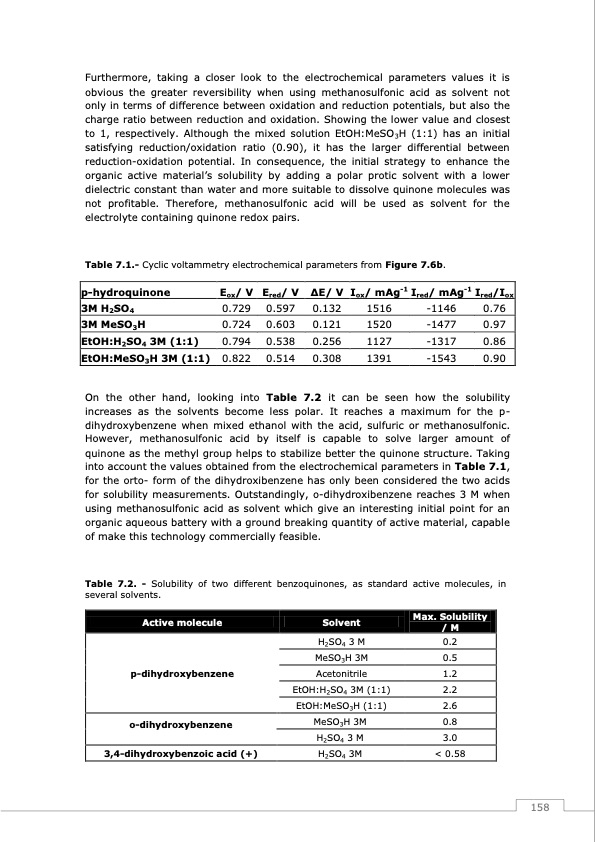
PDF Publication Title:
Text from PDF Page: 159
Furthermore, taking a closer look to the electrochemical parameters values it is obvious the greater reversibility when using methanosulfonic acid as solvent not only in terms of difference between oxidation and reduction potentials, but also the charge ratio between reduction and oxidation. Showing the lower value and closest to 1, respectively. Although the mixed solution EtOH:MeSO3H (1:1) has an initial satisfying reduction/oxidation ratio (0.90), it has the larger differential between reduction-oxidation potential. In consequence, the initial strategy to enhance the organic active material’s solubility by adding a polar protic solvent with a lower dielectric constant than water and more suitable to dissolve quinone molecules was not profitable. Therefore, methanosulfonic acid will be used as solvent for the electrolyte containing quinone redox pairs. Table 7.1.- Cyclic voltammetry electrochemical parameters from Figure 7.6b. On the other hand, looking into Table 7.2 it can be seen how the solubility increases as the solvents become less polar. It reaches a maximum for the p- dihydroxybenzene when mixed ethanol with the acid, sulfuric or methanosulfonic. However, methanosulfonic acid by itself is capable to solve larger amount of quinone as the methyl group helps to stabilize better the quinone structure. Taking into account the values obtained from the electrochemical parameters in Table 7.1, for the orto- form of the dihydroxibenzene has only been considered the two acids for solubility measurements. Outstandingly, o-dihydroxibenzene reaches 3 M when using methanosulfonic acid as solvent which give an interesting initial point for an organic aqueous battery with a ground breaking quantity of active material, capable of make this technology commercially feasible. Table 7.2. - Solubility of two different benzoquinones, as standard active molecules, in several solvents. Iox/ mAg-1 Ired/ mAg-1 p-hydroquinone Eox/ V Ered/ V ΔE/ V Ired/Iox 3M H2SO4 0.729 0.597 0.132 1516 -1146 0.76 3M MeSO3H 0.724 0.603 0.121 1520 -1477 0.97 EtOH:H2SO4 3M (1:1) 0.794 0.538 0.256 1127 -1317 0.86 EtOH:MeSO3H 3M (1:1) 0.822 0.514 0.308 1391 -1543 0.90 Active molecule Solvent Max. Solubility /M p-dihydroxybenzene o-dihydroxybenzene 3,4-dihydroxybenzoic acid (+) H2SO4 3 M MeSO3H 3M Acetonitrile EtOH:H2SO4 3M (1:1) EtOH:MeSO3H (1:1) MeSO3H 3M H2SO4 3 M H2SO4 3M 0.2 0.5 1.2 2.2 2.6 0.8 3.0 < 0.58 158PDF Image | Redox Flow Batteries Vanadium to Earth Quinones

PDF Search Title:
Redox Flow Batteries Vanadium to Earth QuinonesOriginal File Name Searched:
FJVG_TESIS.pdfDIY PDF Search: Google It | Yahoo | Bing
Salgenx Redox Flow Battery Technology: Salt water flow battery technology with low cost and great energy density that can be used for power storage and thermal storage. Let us de-risk your production using our license. Our aqueous flow battery is less cost than Tesla Megapack and available faster. Redox flow battery. No membrane needed like with Vanadium, or Bromine. Salgenx flow battery
| CONTACT TEL: 608-238-6001 Email: greg@salgenx.com | RSS | AMP |